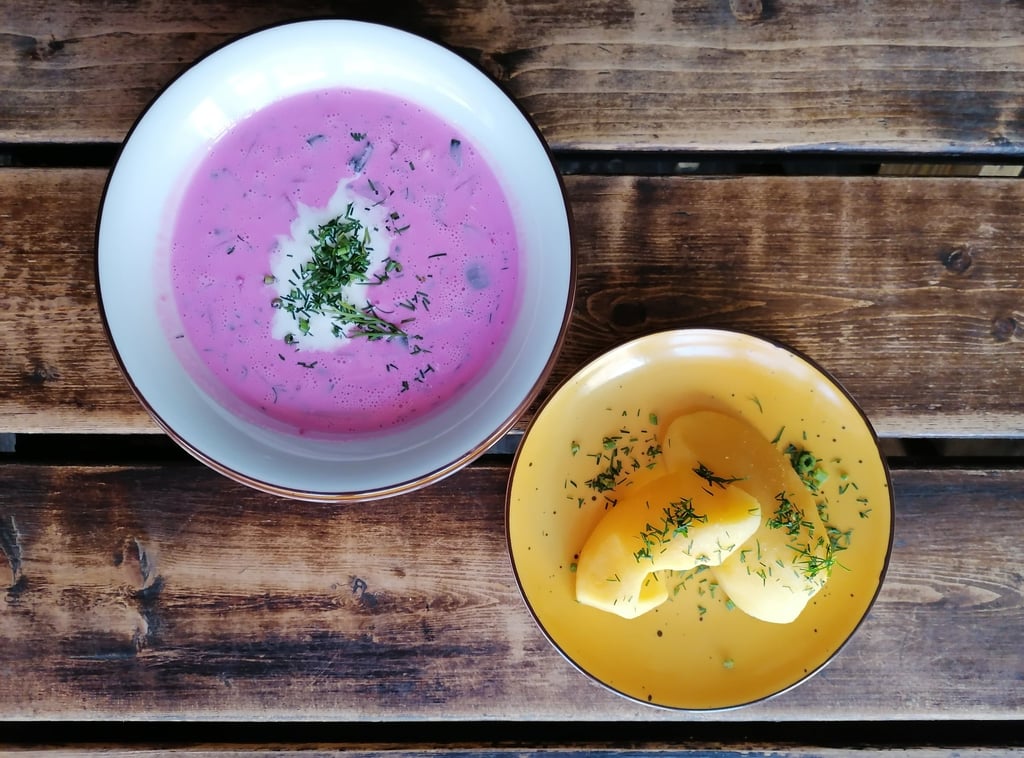

Introduction
Imagine a soup so vibrant it practically glows - neon pink, creamy, tangy and ice-cold. That’s Šaltibarščiai, Lithuania’s one of the most famous and visually striking dish. Often served during the warm spring and summer months, this cold beetroot soup is more than just a meal - it’s a seasonal ritual, a cultural symbol and a beloved national treasure.
In this article, we’ll explore the history, ingredients, preparation, variations and cultural significance of Šaltibarščiai, and reveal why this chilled soup has such a special place in Lithuanian hearts.
What Is Šaltibarščiai?
Šaltibarščiai (pronounced shul-tee-BARSH-chay) literally means “cold borscht” - a cousin to the broader Eastern European beetroot soup family. However, Lithuania’s version is truly unique. This cold, creamy and refreshing dish is made primarily from:
Boiled and grated or chopped beets
Fermented or cultured milk products (traditionally kefir, buttermilk or sour milk)
Cucumbers, dill, spring onions and hard-boiled eggs
Sometimes garnished with sour cream or chives
Always served with hot boiled potatoes on the side
It’s a dish that perfectly balances sweet, sour, salty and earthy flavors. The first spoonful is often surprising, but one bite is usually all it takes to fall in love.
A Brief History
Šaltibarščiai has its roots in Baltic and Slavic culinary traditions, where fermented milk and root vegetables were dietary staples for centuries. Cold soups were common in peasant diets, especially in warmer months when a refreshing, easy-to-prepare meal was welcome.
Lithuanians adapted their own version of cold borscht using kefyras (kefir), which has long been a part of the Lithuanian dairy tradition. With the abundance of beets and fresh herbs in the region, Šaltibarščiai evolved into a distinct dish with a bold identity.
By the 20th century, it had become a beloved staple of Lithuanian households and remains one of the most frequently eaten dishes in the country during the summer.
Ingredients: Simple Yet Flavorful
Despite its stunning appearance, Šaltibarščiai is made from just a few simple ingredients:
Core Ingredients:
Cooked beetroot – grated or finely chopped
Kefir or buttermilk – gives the soup its creamy, tangy base
Cucumber – diced for crunch and freshness
Spring onions – thinly sliced for a mild sharpness
Fresh dill – chopped generously for herbal flavor
Salt and pepper – to taste
Optional Additions:
Hard-boiled eggs – sliced or halved and added to the soup or served on top
Sour cream – for added creaminess
Chives or parsley – as garnish
Served With:
Hot boiled potatoes – plain or lightly salted, traditionally eaten alongside or dipped into the soup
How to Make Šaltibarščiai
One of the biggest advantages of Šaltibarščiai is its simplicity and speed — it can be made in 15–20 minutes once the beets are prepared.
Step-by-Step Recipe:
Prepare the Beets:
Boil fresh beets with the skin on until tender (about 30–40 minutes). Let them cool, peel and grate finely.
Alternatively, use pre-cooked vacuum-packed beets to save time.
Chop Fresh Ingredients:
Dice cucumbers.
Slice spring onions and finely chop dill.
Optionally, chop hard-boiled eggs if mixing them directly into the soup.
Combine the Soup Base:
In a large bowl, mix the grated beets with kefir or buttermilk.
Add cucumbers, spring onions, dill, salt and pepper. Stir well.
Adjust consistency with a bit of cold water if too thick.
Chill Before Serving:
Let the soup sit in the refrigerator for at least 30 minutes.
The flavors deepen and the color intensifies to a vivid pink.
Serve Cold:
Pour into bowls.
Garnish with egg halves, sour cream and extra dill if desired.
Accompany with hot boiled potatoes on a separate plate or on the side.
The Role of Kefir
Kefir, a fermented milk drink similar to buttermilk or yogurt, is crucial to the authenticity of Šaltibarščiai. Its probiotic-rich, tangy profile pairs perfectly with the sweet earthiness of beets. Kefir has long been a part of the Lithuanian diet, valued for its health benefits and digestive support.
For those outside Lithuania, kefir can be found in Eastern European groceries or health food stores. Unsweetened, plain kefir is best for making authentic Šaltibarščiai.
Cultural Significance
Šaltibarščiai is more than a dish - it’s a tradition, deeply embedded in Lithuanian food culture.
It’s a symbol of summer — often the first dish people crave when warm weather arrives.
Found in home kitchens, restaurants and countryside cafés, especially between May and August.
Seen at festivals and outdoor gatherings, sometimes served in paper cups for easy sipping.
Loved by children and adults alike, especially because of its striking pink color and mild, tangy flavor.
Many Lithuanians share stories of eating Šaltibarščiai during school lunch breaks or returning to it after a hot day at the beach or garden. It's both nostalgic and refreshing, a comfort food that cools you down.
Fun Facts About Šaltibarščiai
Instagram-worthy: Its shocking pink color makes it one of the most photogenic dishes in European cuisine.
Color enhancer: The more it sits, the deeper pink it gets - sometimes even staining the potatoes!
Health booster: High in probiotics, fiber, and vitamins from beets, dill and kefir.
International fame: Frequently features on lists of “most colorful” or “most unique” national dishes.
Variations of Šaltibarščiai
Though the traditional version reigns supreme, there are creative interpretations:
Vegan Šaltibarščiai: Made with plant-based yogurt or oat kefir and served with vegan eggs or tofu.
Spicy twist: Some modern chefs add horseradish or mustard for heat.
Gourmet takes: Upscale restaurants may plate it artistically with poached eggs, beet gelée or microgreens.
Blended version: Some prefer blending the soup for a smoother texture.
Still, the rustic, chunky version with visible beet strips and fresh herbs remains the national favorite.
Where to Try Šaltibarščiai in Lithuania
If you’re in Lithuania during the summer, there’s no shortage of places to enjoy an authentic bowl. Some top picks include:
Šnekutis (Vilnius, old town, Šv. Mikalojaus str.) - One of the best Šaltibarščiai in Vilnius.
Etno Dvaras (Vilnius) – A tourist-friendly spot that serves traditional dishes with flair.
Bernelių Užeiga – Known for hearty portions and rural atmosphere.
Senoji Trobelė – Rustic and cozy with authentic presentation.
Local countryside guesthouses and cafes – Often serve it as part of a set lunch.
Or better yet, visit during a local festival or picnic, where giant vats of the soup are prepared for sharing.
Final Thoughts
Šaltibarščiai is more than just a cold beet soup - it’s a colorful emblem of Lithuanian identity. With its bold appearance, refreshing flavor and deep cultural roots, it stands out as one of the most unique dishes in European cuisine. Whether you're sipping it at a countryside kitchen table, a restaurant in Vilnius or recreating it at home with farmers' market beets, this soup brings a taste of Lithuanian summer straight to your plate.
So the next time you’re craving something cool, healthy and vibrant - remember the pink soup from Lithuania. Šaltibarščiai is not just food. It’s tradition in a bowl.




